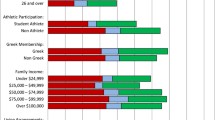Abstract
Adolescents' alcohol-related attitudes and behaviors may be affected by marketing efforts of the alcohol industry, retailers, and the catering industry. Most research has focused on the effects of commercials and media exposure. This article investigates another aspect of alcohol marketing in the Netherlands: the use of alcohol discounts by cafés. The prevalence of alcohol discounts was studied using unobtrusive café observations and website content analysis. It is estimated that 39% of the cafés offer some kind of cash discount for alcoholic beverages. The effects of alcohol discounts were investigated in a survey among adolescents (14–17 years old, N=409). Adolescents reported using alcohol discounts eight times a year, and consuming more alcohol when discounts were offered. Alcohol discounts, however, do not attract adolescents to visit particular cafés and/or to spend more money when going out. No differences were found between minors (16–17 years) and underage adolescents (14–15 years).
Similar content being viewed by others
References
NIAAA. The effects of alcohol on physiological processes and biological development. Alcohol Res Health. 2004/2005;28:125–131.
NIAAA. Genetics, pharmacokinetics, and neurobiology of adolescent alcohol use. Alcohol Res Health. 2004/2005;28:133–142.
Bonomo YA, Bowes G, Coffey C, Carlin JB, Patton GC . Teenage drinking and the onset of alcohol dependence: a cohort study over seven years. Addiction. 2004;99:1520–1528.
Wells JE, Horwood LJ, Fergusson BM . Drinking patterns in mid-adolescence and outcomes in late adolescence and early adulthood. Addiction. 2004;99:1529–1541.
Van de Pol M, Duijser E . Meting alcoholgebruik jongeren. Onderzoek onder Nederlandse jongeren 10 t/m 15 jaar. [Measurement of Adolescent Alcohol Use. Investigation Among Dutch Adolescents Between 10 and 15 Years Old]. Amsterdam: NIPO; 2003.
Monshouwer K, Van Dorsselaer S, Gorter A, Verdurmen J, Vollebergh W . Jeugd en riskant gedrag. Kerngegevens uit het peilstationsonderzoek 2003. [Youth and Risky Behavior: Core Figures from Monitoring Study 2003]. Utrecht: Trimbos Institute; 2004.
Jackson MC, Hastings G, Wheeler C, Eadiel D, Mackintosh AM . Marketing alcohol to young people: implications for industry regulation and research policy. Addiction. 2000;95:S597–S608.
Hastings G, Anderson S, Cooke E, Gordon R . Alcohol marketing and young people's drinking: a review of the research. J Public Health Policy. 2005;26:296–311.
Casswell S . Alcohol brands in young peoples' everyday lives: new developments in marketing. Alcohol Alcoholism. 2004;39:471–476.
Richter L, Vaughan RD, Foster SE . Public attitudes about underage drinking policies: results from a national survey. J Public Health Policy. 2004;25:58–77.
Gosselt J, Van Hoof J, De Jong M . Alcohol en jongeren in Zuidoost-Brabant. Nulmeting nalevingsonderzoek en draagvlakonderzoek. [Alcohol and Youth in Zuidoost-Brabant: A Baseline Compliance and Policy Support Study]. Enschede: University of Twente; 2007.
Gosselt JF, Van Hoof JJ, De Jong MDT, Prinsen S . Mystery shopping and alcohol sales: do supermarkets and liquor stores sell alcohol to underage customers? J Adolesc Health. 2007;41:302–308.
Toomey TL, Wagenaar AC . Policy options for prevention: the case of alcohol. J Public Health Policy. 1999;20:192–213.
Jernigan DH, Ostroff J, Ross C . Alcohol advertising and youth: a measured approach. J Public Health Policy. 2005;26:312–325.
Casswell S, Maxwell A . Regulation of alcohol marketing: a global view. J Public Health Policy. 2005;26:343–358.
Grossman M, Chaloupka FJ, Saffer H, Laixuthai A . Effects of alcohol price policy on youth: a summary of economic research. J Res Adolesc. 1994;4:357–364.
Christie J, Fisher D, Kozup JC, Smith S, Burton S, Creyer EH . The effects of bar-sponsored alcohol beverage promotions across binge and nonbinge drinkers. J Public Policy Marketing. 2001;20:240–253.
Kuo M, Wechsler H, Greenberg P, Lee H . The marketing of alcohol to college students: the role of low prices and special promotions. Am J Prev Med. 2003;25:204–211.
STIVA. The Advertising Code for Alcoholic Beverages with Guidelines. Den Haag: Stiva; 2006.
Author information
Authors and Affiliations
Corresponding author
Additional information
Discounts are used to promote alcohol sales to adolescents in the Netherlands, affecting both attitudes and consumption.
Rights and permissions
About this article
Cite this article
van Hoof, J., van Noordenburg, M. & de Jong, M. Happy Hours and Other Alcohol Discounts in Cafés: Prevalence and Effects on Underage Adolescents. J Public Health Pol 29, 340–352 (2008). https://doi.org/10.1057/jphp.2008.2
Published:
Issue Date:
DOI: https://doi.org/10.1057/jphp.2008.2




